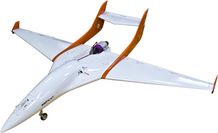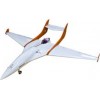
Description
airborne target robotic complex «BERKUT» is designed for performance of a wide range of tasks:
- flying around anti-aircraft missile systems (AAMS) with the aim of training the crew in working conditions for various types of targets;
- assessment of actual, but not declared in technical specifications, performance characteristics of firing radars (AMIS: air missile interception system): target detection range with various reflecting surface efficiency (RSE), accuracy of tracking such targets in terms of distance, speed and angular coordinates;
- assessment of accuracy of geodetic connection and orientation of firing RS AAMS significantly influencing upon efficiency of target designation from external systems;
- firing tests AAMS(AMIS);
Airborne target «BERKUT» is designed for imitation of airborne threat of RPV type, cruise missiles and subsonic airplanes of tactic aviation, while carrying out combat preparation of calculations, flyby and firing tests in all modifications of anti-aircraft missile complexes (AAMS) S–125 with imitation of targets both for target illumination radar (TIR) 5N62 and for semiactive homing head (SHH) 5G23 and radio fuze ZUR V-860. Various modifications of equipment of «BERKUT» airborne target ensure solution of similar tasks for a wide range of AAMS as well as airborne missile interception complexes (AMIS) produced in NATO countries and countries of the former USSR (RF). Active radar response with the required level of the retransmitted signal of active REM (radio electronic means) AMIS is a promising and reliable way of RSE imitation of typical airborne targets on board of a low-sized carrier barely visible for radars.
Target «BERKUT» imitates RSE of typical airborne targets such as: “air-surface” cruise missiles with the planner based on Stealth technology with RSE 0.1…1.0 m² and low-sized reconnaissance UAV cruise missiles without application of Stealth technology, CM (cruise missiles) with aerial ARHH(active radar homing heads) systems, shocking UAV, training airplanes etc. AV (airborne vehicle) with RSE 1.0…3.0 m²; FA (fighter aviation) airplanes, multipurpose FA airplanes, airplanes of light front-line aviation and low-flying attack aircrafts with RSE 5.0…10.0 m², heavy airplanes of front-line aviation with RSE up to 15.0 …20.0 m²; combat and transportation airplanes, AEW airplanes, fuellers etc. with RSE more than 30m3. Frequency range of imitated reflected signal is determined by the range of BRS and ARHH AFM (air-fired missile) frequencies. Almost all world BRS park of AMIS fighters of F 14C, F 15, F 16, F 18, types, “Tornado” F2, F3, “Mirazh 2000”, F 22 A, “Rafael”, EF 2000, equipped with missiles with active RHH (radar homing head) of AAAM, AIM-120А,В AMRAAM, MICA types, “Skyflash 90”, with missiles with seactive RHH of AIM 7E,F,M type, “Sparrow”, fighters AMIS MiG–29, Su 27, Su–30MKK, Su–30MKI, Su–30MKM equipped with missiles with semiactive RHH of Р–27 type, uses 3cm waveband. «BERKUT» robotic airborne target with airframe hull made of composition materials and turbojet engine uses airplane type of performing major part of its route and parachute landing.
Characteristics
Engine turbojet
Statistical traction N 9-230
Fuel consumption ml/min 179-730
Key geometric characteristics
Length mm 2384
Span of wings mm 2800
Weight data
Takeoff mass kg 34
Standard fuel margin ml 8200
Basic flight characteristics
Range of horizontal flight speed km/h 100-400
Cruise speed km/h 150
Takeoff speed km/h 90
Flight attitude range m 50-3500
Practical flight length km 110
Flight duration minutes 30
Control
Flight control Automatic/dual
Communication range (within line of sight) km 100
Control system Autonomous navigation, automatic performance of the flight task





